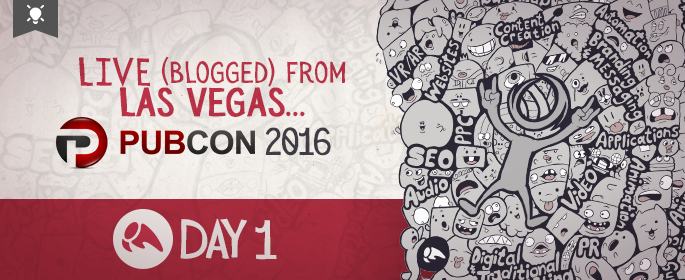
Another two-part session here today – we’re ready to share some key takeaways you need to know about remarketing.
B2B Remarketing: Erin Heffernan, Account Director, Optimedia
What Erin begins by looking at, from a paid search point of view, is the paid search conversion funnel. She knows the highest searched terms usually have the lowest conversion rate. They’re super generic. However, the lower the search volume (and the more specific the search term), the higher conversion rate.
They look at their funnel (category, brand, product from widest to narrowest) and identify what they want to achieve. Keywords and search phrases tend to fall into the following categories:
- High conversion value, low volume (demand generation)
- High conversion value, high volume (demand generation)
- Low conversion value, low volume (ignore)
- Low conversion value, high volume (brand awareness)
After they figure out their four segments, they layout a strategy for how they’re going to collect cookies and what lists they’re going to form. Site-level cookies: We don’t care what page, we just want to stay in front of them. Or home page-level cookies: Maybe we don’t want to target them, since they didn’t browse anywhere. Categories & sub-category level: People viewed particular pages or products. How can we segment and/or combine these lists of people to achieve the goals we’re looking for, and to sell the products we want to sell?
Once they have their strategy in place, they have to identify how they are going to make the biggest impact. There are three factors:
- Experiences: Use appropriate landing pages based on goals, cross-promote appropriately, drive people deeper down the funnel.
- Ad copy/ad formats: Update ad copy according to goals and user lists. Experiment with different ad formats. Tip: Make sure you’re looking at the preview of your ads, to make sure you’re getting your point across well.
- Bidding: How are we going to set up campaigns, and what are we setting up bids to be based on user values.
What are some results she’s seen?

Tip from Erin: Know your sales cycle. Use the sales cycle to decide how long to keep someone on a remarketing list.
In addition, keep in mind how many lists your user could fall into, as well as how often you’re getting in front of them. By seeing how much you’re actually showing your ads to your user, you can make sure you have the appropriate frequency caps set.
Finally, remember you can remarket using OR, i.e. “People who visited printers OR ink.”
Erin’s summary: Remarketing is low-hanging fruit. But you must have a strategy, and you must always focus on user experience.
B2C Remarketing: Jim Banks, Director of Paid Media, Groove
Jim’s ready to tell us about a few types of remarketing. Catch his takeaways below.
Bid Only:
- Keyword-based
- Modify bid based on keyword list
- Can be positive or negative
- Easiest to set up
- Easiest to screw up
Conversion rate of an existing client, or someone that has been to his site before, is hugely different than someone who has never been there. He advises us to look at our analytics. This should give us an indication of who is most valuable to us, and whether our data aligns with his experiences.
For bid only remarketing, Jim says to set up a 30-day list, shorter if your sales cycle is shorter. For people that bought from you in the past, you can choose to exclude them, or you can target them directly – segment your messaging appropriately if you are remarketing to past customers.
Only segment to particular audiences if that segment is large enough to be worthwhile.
Target & Bid:
This type allows you to change your message based on whether they’ve interacted with you before or not. Choose to segment by existing visitors vs. new visitors. Use more broad keywords with target restrictions. You can also use different creative.
You can set up lots of ad groups with different configurations, looking at topics, affinities, gender, age, keywords, etc. For all of this customization, remember that this takes proportionately more time to set up, so plan for that.
Dynamic Remarketing:
Dynamic ads have a lot of moving parts. You need to connect your merchant center feed, and handle shopping cart configuration anomalies. It’s incredibly complicated, even if it seems like it should sound easy.
Jim’s tips for dynamic remarketing: Use high quality images, and make sure your ads have a white background. Include ALL products – even if you exclude them in Google Shopping. You can only remarket to people in dynamic remarketing if you have the product in your feed.
Set up image-based ads, text ads and native ads separately, unless you’re strapped for time. By default, you can blanket your messaging and preferences to set them all up at the same time – but if you keep them separate, you can adjust for the fact that audiences (and their preferences) for text-based ads, image-based ads, etc. can be different.
Beyond these, there are other options to look at, such as Facebook remarketing. Jim notes that Facebook Analytics for Apps recently launched cross-platform analytics. The insights here are exciting, and are going to help further leverage remarketing as a tactic to raise awareness of your products and services.





